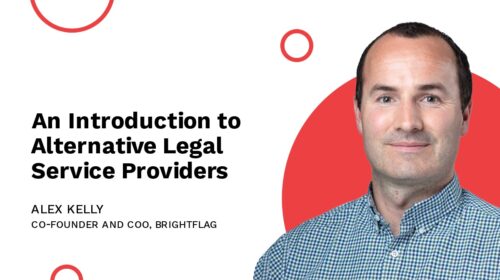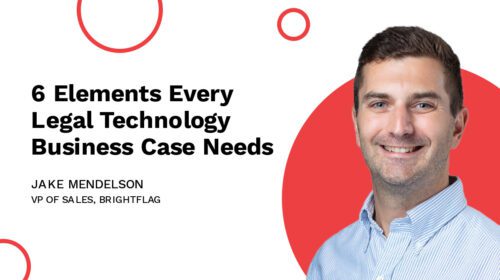5 Ways Legal Department Management Software Helps Cut Costs
In-house teams are in a tough spot when it comes to improving legal service delivery. On the one hand, the demands on the legal department seem to grow every year. Yet at the same time, their access to the resources they need to meet those increasing demands has remained stagnant—or, worse, has started to dwindle.
Amid this pressure, legal technology has emerged as a powerful lever for making the most of the resources in-house teams do have. Notably, enterprise legal management (ELM) platforms like Brightflag, which leverage AI and automation, help legal teams streamline operations, improve visibility into work and spend, and make data-driven decisions that enhance cost-efficiency.
In this post, we’ll explore five key ways legal department management software helps in-house legal teams control costs—by giving teams the tools they need to optimize value from their current resources and budget.

What is Legal Department Management Software?
Legal department management software is a category of technology solutions designed to help in-house legal teams and departments operate more efficiently, reduce risk, and manage their legal workflows, budgets, and vendor relationships more effectively. These legal software platforms are central to legal operations and often integrate various tools and functionalities into a single interface.
The key components of legal department management software are typically e-billing, matter management, and reporting. With all-in-one solutions that incorporate these components, billing and matter management act as the legal department’s system of record, with reporting helping legal teams understand and improve their work.
Legal department management software may also include contract and legal document management solutions. Oftentimes, it’s best to use dedicated, best-in-class legal software solutions for these particular tasks.
With this in mind, here are 5 ways legal department management software can help control costs:
1. Real-Time Spend Tracking and Better Budget Discipline
One of the most fundamental benefits of legal department management software is its ability to centralize data on legal spend. E-billing and matter management platforms like Brightflag, for example, create a unified system of record that enables in-house legal professionals to track spend across matters, law firms, and practice areas on centralized dashboards.
With this visibility, legal departments gain real-time insights into spending trends, making it easier to identify and address budget risks early. For example, if costs unexpectedly spike in a particular matter or practice area, the team can proactively investigate and adjust course before the problem escalates.
Beyond immediate issue-spotting, historical spend data can inform future budget planning. Instead of relying solely on last year’s spend as a rough baseline, legal teams can build more precise forecasts by looking at complete historical spend—improving alignment with finance and the broader business in the process.
2. Cost-Optimized Resourcing
Legal work doesn’t adhere to a one-size-fits-all resourcing model. Some tasks—such as bet-the-company litigation or high-stakes deals—require the expertise of a top-tier law firm. Others, like routine contract reviews or discovery, may be better handled in-house or by alternative legal service providers (ALSPs).
Legal department management software provides the data foundation to make these resourcing decisions with confidence. Platforms like Brightflag help legal teams analyze spend patterns, resourcing mixes, and outcomes across matters.
With this intelligence, departments can:
- Identify lower-risk work that can be moved in-house at a lower cost, avoiding rising external fees.
- Shift routine or low-complexity work to ALSPs, often at significantly lower rates.
- Negotiate more efficient staffing models with firms, such as reducing unnecessary partner time.
As Brightflag’s Outside Counsel Benchmarking Report points out, resourcing decisions are one of the greatest levers legal teams can pull for cost efficiency. By rightsourcing outside counsel engagements and ensuring the right people are working at the right levels of seniority, legal departments can improve both cost and outcomes.
3. Outside Counsel Benchmarking and Better Rate Negotiations
One of the most powerful features of legal department management platforms is their ability to surface vendor benchmarking insights. Without technology, most legal departments struggle to compare performance or pricing across vendors. With the right tools, teams can evaluate:
- Blended rates across firms (i.e. the average price per hour across all timekeepers)
- Timekeeper-level rates and how they compare to market norms
- Compliance with outside counsel guidelines
- Performance metrics such as budget adherence, work quality, and responsiveness
Armed with this data, legal departments can make more informed decisions about outside counsel engagements—for example, sending more work to their most cost-effective, reliable firms.
Brightflag’s Outside Counsel Guidelines reinforce the importance of setting clear expectations around timekeeper rates, rate increases, and budgeting to prevent cost overruns. When those guidelines are combined with vendor performance data, legal teams can have more constructive, data-driven conversations with their firms.
4. Cost Savings Through Automated Invoice Review
Manual invoice review is one of the most time-consuming—and error-prone—tasks that the in-house team can work on. Without automation, legal teams must pore over thousands of line items, trying to catch noncompliant charges, duplicate entries, and other issues like block billing.
Legal department management systems like Brightflag change the game by automating the invoice review process. Using AI and configurable billing guidelines, these platforms can flag noncompliant charges, enforce outside counsel guidelines, and route invoices for the appropriate approvals.
The benefits are twofold:
- Increased efficiency: Legal teams spend less time on administrative task management and more time on high-value legal work.
- Enhanced cost control: Automated checks help catch billing errors or guideline violations that might otherwise slip through the cracks—ensuring the department only pays for approved, value-adding work.
As Brightflag’s Legal Cost Control Checklist illustrates, billing hygiene is the ‘engine oil’ of cost control. Without structured, timely, and compliant invoices, legal teams can’t effectively assess or manage costs. Automated review systems ensure that invoices meet the legal team’s standards, helping legal departments avoid budget surprises and overpayments.
5. Increased Efficiency Through Contract Lifecycle Management (CLM)
Contracts are the lifeblood of most organizations, but managing them manually can be slow, error-prone, and costly. Contract Lifecycle Management (CLM) solutions address this challenge by automating key stages of the contract process, from drafting to execution and renewal.
Modern CLM platforms typically offer:
- Template libraries and clause banks to streamline drafting
- Automated workflows to manage approvals and signatures
- Centralized repositories for easy access and reporting
The advent of generative artificial intelligence (GenAI) tools has accelerated these capabilities even further, with AI trained on legal data capable of suggesting clauses based on contract type and highlighting any language or terms your team needs to scrutinize.
AI has also become increasingly skilled at identifying deviations from standard clauses, inconsistent terms and other (potentially costly) issues, making these tools a great copilot for your team during contract review.
What does all of this add up to? A smoother document and contract management process. One that saves valuable time, controls costs and frees up employee capacity, while simultaneously reducing the likelihood of errors that can arise during manual contracting processes.
Tackling Legal Cost Control with Brightflag
The pressure on corporate legal departments to become more cost-efficient isn’t going away. But the good news is that legal tech now provides a robust set of tools to help in-house teams control costs without compromising on quality or outcomes.
For legal leaders who want to take their cost-control strategies to the next level, enterprise legal management platforms like Brightflag offer an integrated approach: combining e-billing, matter management, and analytics in one AI-powered system.
Ready to see how Brightflag can help your legal team achieve its cost-control goals? Book a demo today and discover how our user-friendly platform can help you drive efficiency and savings across your legal department.


